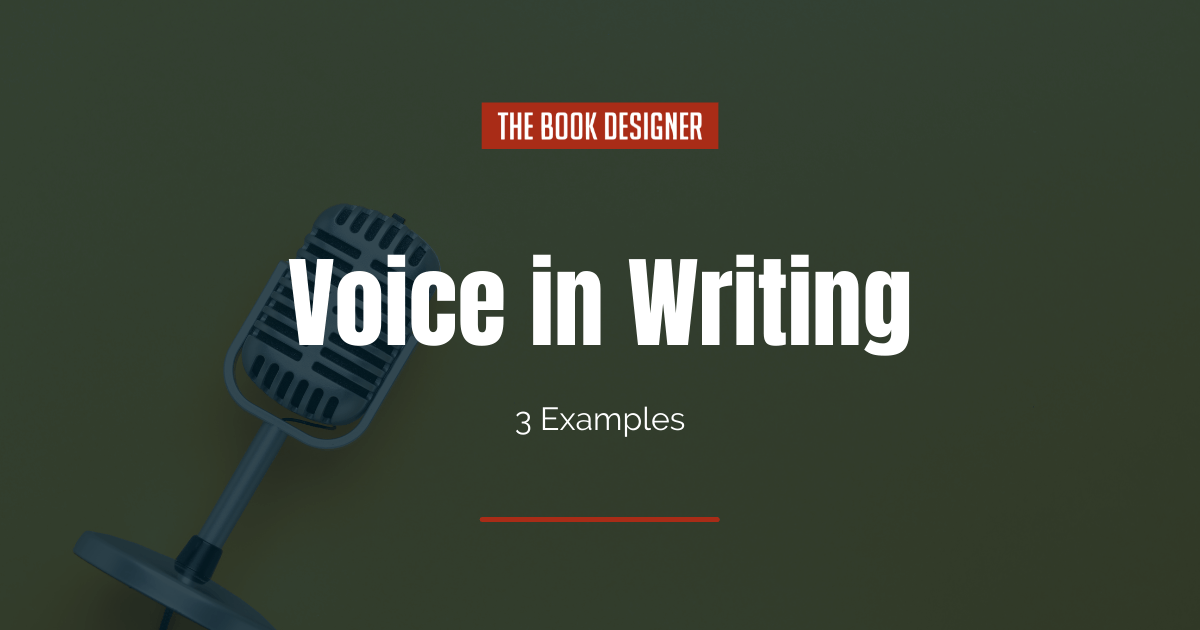Many authors are recognizable from a single sentence: William Shakespeare, Jane Austen, and Ernest Hemingway, just to name a few. We know their work because they have a distinct author’s voice.
- “To be, or not to be: that is the question.” -Shakespeare
- “A lady’s imagination is very rapid; it jumps from admiration to love, from love to matrimony in a moment.” -Austen
- “You can’t get away from yourself by moving from one place to another.” -Hemingway
Likewise, there are many characters that are recognizable from a single piece of dialogue, like Atticus Finch, Sherlock Holmes, and Matilda Wormwood. They have a distinct character voice. You can just hear Sherlock say, “You know my methods, Watson.”
These two types of voice, along with the narrator’s voice, make up the tone and feel of every fiction book.
Definition & Meaning of Voice in Writing
In writing, “voice” refers to the mixture of tone, word choice, point of view, syntax, punctuation, and rhythm that make up sentences and paragraphs. Novels can have many voices, like those of the author, the narrator, and the individual characters. When developing voice in writing, you may choose to break conventional grammar rules in favor of the narrative value from voice.
Different Voices in Writing
There are three distinct types of voice in writing: the character’s, the author’s, and the narrator’s.
These voices are not always discrete, but they are always present.
Character’s Voice
Character voice is the easiest type of voice to distinguish. Each character, even minor characters, should have an individual voice. A character’s voice is conveyed through their thoughts, personality, and speech.
A character’s thoughts can be revealed through dialogue tags, an in-depth point of view (first person or third-person limited), and word choices. Their thoughts can reveal true motives that may be at odds both with what they say and do.
A character’s personality comprises the things they do and say. It is a complex web of characteristics that reveals who they are and how they see the world. Two characters presented with the same situation will probably interpret it entirely differently.
A character’s dialogue can convey a myriad of information, including their mood, age, experience, health, and emotion. If a character is old, they may have a world-weary voice that speaks of experience. If a character is young, they may have a naive and preppy tone.
Author’s Voice
An author’s voice comprises everything from tone to word selection to punctuation. It is all the qualities that make a writer unique.
When presented with a trip to the park, one writer may focus on the feel of the sun and breeze on their character’s face, whilst another may describe the people the character passes. The difference in the writers’ world views creates this contrast between the descriptions.
Some author voices are instantly recognizable, regardless of the topic, for example, Stephen King. His 60-plus books all cover different themes, use original characters, and have different storylines.
Despite this, there is an undeniable connection among them all: King’s author voice. This recognizable voice was the key reason that King’s pseudonym Richard Bachman was outed in 1985, just eight years after he began writing under it.
Narrator’s Voice
The narrative voice is the perspective from which a story is told. There are four types of narrative voice or point of view (POV): first person, second person, third person limited, and third person omniscient.
- First Person: The narrator is also a character and they use pronouns such as “I” and “we.”
- Second Person: The reader seemingly becomes a character in the story through the use of the pronoun “you.”
- Third Person Limited: The narrator exists outside of the story and uses pronouns like “he,” “she,” and “they”.
- Third Person Omniscient: An all-knowing narrator who exists outside of the story. This could be the author or an unnamed entity who uses third-person pronouns.
As described above, the narrator’s voice can be the same as the author’s voice, one of the characters’ voices, or it can be totally discrete.
Examples of Voices in Writing
It can be difficult to distinguish among the different types of voice, so we will look at two examples together: The Great Gatsby and The Wind in the Willows.
Examples of Character Voices
Jay Gatsby, from The Great Gatsby, has a very recognizable voice because of his sophisticated tone and often-repeated phrases such as “old sport.”
“I thought you knew, old sport. I’m afraid I’m not a very good host.”
The Badger is instantly recognizable in The Wind in the Willows due to his serious and stoic nature, coupled with his perfect etiquette.
‘Well, then,’ went on the Badger, ‘we—that is, you and me and our friend the Mole here—we’ll take Toad seriously in hand. We’ll stand no nonsense whatever. We’ll bring him back to reason, by force if need be. We’ll make him be a sensible Toad.’
Examples of Author Voices
F. Scott. Fitzgerald was a careful, wry, and sophisticated writer who heavily utilized complex sentence structures, as evidenced below.
The abnormal mind is quick to detect and attach itself to this quality when it appears in a normal person, and so it came about that in college I was unjustly accused of being a politician, because I was privy to the secret griefs of wild, unknown men.
Whereas Fitzgerald looks inward at the mind, Kenneth Grahame looks outward at the beauty of the world. He is very playful and free with his words.
Hither and thither through the meadows he rambled busily, along the hedgerows, across the copses, finding everywhere birds building, flowers budding, leaves thrusting—everything happy, and progressive, and occupied.
Examples of Narrator Voices
Nick Carraway, an intelligent reflective young man, narrates The Great Gatsby. Fitzgerald overcomes the limitations of a first-person narrator by framing the story two years in the past, thereby giving Nick a chance to obtain information he would not have had in the moment.
In my younger and more vulnerable years my father gave me some advice that I’ve been turning over in my mind ever since.
Kenneth Grahame uses a third-person omniscient narrator to tell the story of toad, mole, rat, and badger. This form of narration allows all four characters to take a leading role and for the narrator to explain things of the animal world that are unfamiliar to the reader.
The Mole had been working very hard all the morning, spring-cleaning his little home.
Conclusion on What Voice in Writing Is & Its Importance
Distinct author voices are one of the primary reasons that people have “all-time favorite authors.” Finding your voice is essential to gaining a dedicated following.
Your voice is just as important as the story. It dictates how and why you tell a story and how your readers experience the story. Without a distinct voice, novels are just a jumble of words.
Author bio:
Millie Dinsdale creates writing resources and articles for ProWritingAid. A recent English Literature graduate, she is obsessed with how the right words can help you get your ideas across in the best way.





